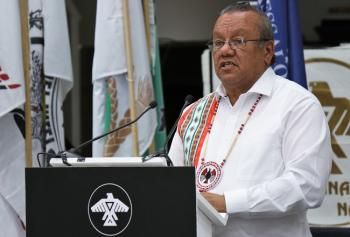Image Caption
Summary
Windspeaker.com Contributor
Two things are inevitable, says Anishinabek Nation Grand Council Chief Glen Hare: There will be nuclear power generation on their traditional lands despite First Nations’ opposition and storage of nuclear waste will lead to a disaster.
“Take (the storage) inland. At least it can be monitored a hell of a lot better than right by the shores. Mother Nature is fighting and fighting back big time. You see these fires? You see everything? Wait until these waters get wild,” he said.
Hare’s comments come a week after Ontario Premier Doug Ford signed a memorandum of understanding with the premiers of Saskatchewan and Manitoba “to work collaboratively in support of the development and deployment” of Small Modular Reactors (SMRs), which includes nuclear waste management.
In October, Hare and a committee of chiefs met with Ford and asked him to consider putting any deep geologic repository (DGR) for nuclear waste in-land, 50 to 100-km away from any water source. Chiefs were concerned that the focus for DGRs was along the Chalk River and Owen Sound in the Saugeen Ojibway Nation’s traditional territory.
“The premier said they get so many recommendations, 30 or 40. I said, ‘I bring only one to you from the Anishinabek Nation,’” said Hare.
That recommendation and the meeting with Ford came four months after the Anishinabek Chiefs-in-Assembly unanimously endorsed a Grand Council Resolution opposing SMRs. The resolution passed in June stated clear opposition to the construction, operation, storage or disposal of SMRs in the territory of the Anishinabek Nation, including bodies of water.
“They’re going to do it anyway, even though they consult, don’t consult. They’re going to do it. I said that to the premier. ‘It’s going to happen, I can see it, because I know you support it. But at least that’s what we’re recommending. If you’re going to do it, put it 50 to 100-km in-land,’” said Hare.
He says they received no commitment from Ford.
Now Hare points out he has heard that money is being spent to bring SON on board for a DGR.
That belief was confirmed in an article in the Owen Sound Sun Times on Dec. 9. The Sun Times said it had obtained a copy of a letter from Ontario Power Generation in which $150 million would be given to SON if members supported a DGR to store low- and mid-level nuclear waste at the Bruce nuclear site in the rock beside Lake Huron.
SON’s Facebook page announced a vote for the project to be held on Jan.31, 2020. Members 16 years and over are eligible to vote.
“The people who are going to bury this, there’s certainly money here somewhere, big money. And if disaster ever hits, these people don’t live close to here. They’re on the other side of the pond. They’re not going to suffer. It’s us. Every one of us here,” said Hare.
The tri-province MOU calls for Indigenous engagement. It also sets fall 2020 as the timeline by which the energy ministers from the three provinces will develop a strategic plan for SMR deployment.
Hare says that timeline is “rushed.”
His view is upheld by a report prepared by the Canadian SMR Roadmap Steering Committee, consisting of provincial and territorial governments, and power utilities and supported by Natural Resources Canada. That report, released in late 2018, called for “two-way engagement with Indigenous peoples and communities … well in advance of specific project proposals.”
The report noted that Indigenous engagement was not a “one-time checklist exercise.” It also called into consideration the “important historical context (with Indigenous peoples) beyond nuclear power, which has included many mistakes and failures that have led to an erosion of trust. Much work is needed to rebuild trust.”
Hare says he would like to see provincial consultation undertaken with the Chiefs of Ontario who meet in assembly twice annually.
“Don’t go to (Nishnawbe Aski Nation) where there’s a certain amount of First Nations, then come to us. Don’t do it in pieces. The effects are the same everywhere. Visit us all and not in pieces and (then) say, ‘We got NAN, we got Treaty 3, but we don’t have here.’ Then they might say, ‘We’ve got more numbers here, we might just go here,’” said Hare.
First Nations Power Authority President and CEO Guy Lonechild told Windspeaker.com following a green energy forum in November that FNPA was looking at the “whole spectrum of clean energy, so small modular reactors for northern and remote Canada where transmission lines may never get built…We’re in discussion with a number of players in the SMR technology.”
Repeated attempts to reach Lonechild for further comments were unsuccessful.

